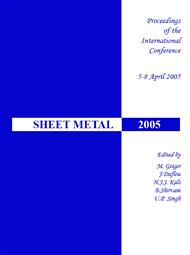p.657
p.665
p.673
p.681
p.689
p.697
p.705
p.713
p.721
Experimental and Numerical Investigation of the Formability of Laser Welded Patchwork Blanks
Abstract:
Within the past decades tailored welded blanks have become a key product for the construction of lightweight automotive bodies. Following the principle of applying material only where it is really needed results in an improved stiffness and crash worthiness of the body-in-white, while at the same time weight and production costs may be reduced. An alternative to the concept of tailored blanks is the so-called patchwork blank technique. The principle of patchwork blanks is to add a flat piece of sheet metal onto the main blank in the areas where reinforcements are required. The assembly can be done by adhesive bonding, resistance spot welding or laser welding prior to forming. The major benefits of this technique in comparison to tailored blanks are the abolition of cutting operations and a high flexibility regarding the shape and position of the reinforcement. Even if there is a big application potential for patchwork blanks in automobile production, practical realisation of this innovative technique is hindered due to a lack of knowledge regarding the formability of patchwork blanks. In this study the formability of laser welded patchwork blanks is investigated by means of experimental trials and finite element analysis. In order to simulate accurately the forming processes of patchwork blanks using finite element analysis, knowledge about the characteristics of the weld metal, including the weld bead and the heat affected zone, is essential. Microhardness measurements have been applied to analyse the heat affected zone and to determine its lateral dimensions. The constitutive behaviour of the weld metal has been investigated by uniaxial tensile tests with a special sample geometry. The results obtained from these experimental investigations have been used to define different modelling techniques for the finite element analysis of patchwork blank forming processes. It can be shown that the consideration of the modified material properties along the weld seam leads to an improvement of the accuracy of the numerical calculation.
Info:
Periodical:
Pages:
689-696
Citation:
Online since:
May 2005
Authors:
Keywords:
Price:
Сopyright:
© 2005 Trans Tech Publications Ltd. All Rights Reserved
Share:
Citation:


